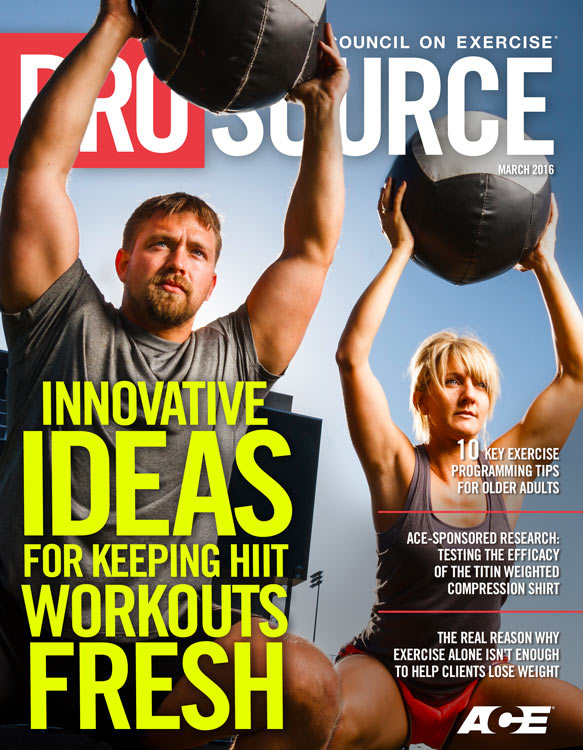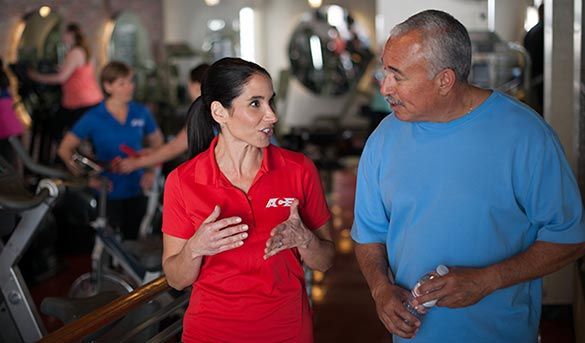
The Cost of Physical Inactivity
Physical inactivity is associated with numerous unhealthy conditions, including obesity, hypertension, type 2 diabetes and atherosclerotic cardiovascular disease (CVD), and contributes annually to an estimated 250,000 premature deaths (Booth et al. 2000).
Older Americans are currently both the least physically active and the most rapidly growing of any age group. For example, the prevalence of inactivity among adults ages 65 to 74 and those 75 years of age and older is 35.7 percent and 51.9 percent, respectively. Moreover, over the next few decades millions of baby boomers will turn 65 years of age (Nelson et al., 2007). These factors make it increasingly likely that, as a health and fitness professional, you will be interacting with clientele other than apparently healthy adults. Older adults often deal with challenges such as balance impairments, osteopenia, sarcopenia and other health-related disorders, all of which dictate unique modifications to their exercise programs. This article outlines 10 key exercise-programming tips for creating effective exercise programs for your older adult clients.
The Physiology of Aging
Older adults can be defined as men and women age 65 and older, and adults age 50 to 64 years who have clinically significant chronic conditions and/or functional limitations that impact movement ability, fitness or physical activity (Nelson et al., 2007). Despite these age ranges, you should not erroneously assume that chronological age equates to physiological or functional age. Indeed, persons of similar ages can differ remarkably in functional capacity, which in turn affects how these individuals respond to exercise. Although it is inevitable that physiological function will decline with age, the rate and magnitude of change is dependent on a complex interaction of genetics, individual health, presence of disease or injury, and exercise history. Safe and effective exercise programming for older adults requires that you have knowledge of the effects of aging on physiological function at rest and throughout the exercise intensity spectrum. A list of key physiological aspects of aging is presented in Table 1. Being aware of the physiological aspects of aging will help you and your clients establish realistic program goals.
Previously sedentary older adults commencing with an exercise program can expect improvements in numerous health parameters. However, due to the natural decline in function associated with aging, you should also view maintaining function as a successful exercise-program outcome. For example, it has been demonstrated that people experience an average 1 percent decrease in cardiorespiratory fitness per year (Dempsey and Seals, 1995). If you work with a client for several years and observe no change in his or her cardiorespiratory fitness level over that timeframe, you have, in fact, designed and implemented an effective program because the inevitable decline in physiological function, in this case cardiorespiratory fitness, has been delayed.
When designing exercise programs for older adults, keep these three overarching goals in mind:
- Prevent or delay the progression of chronic diseases
- Maintain or enhance cardiorespiratory fitness levels
- Prevent functional limitations and disabilities
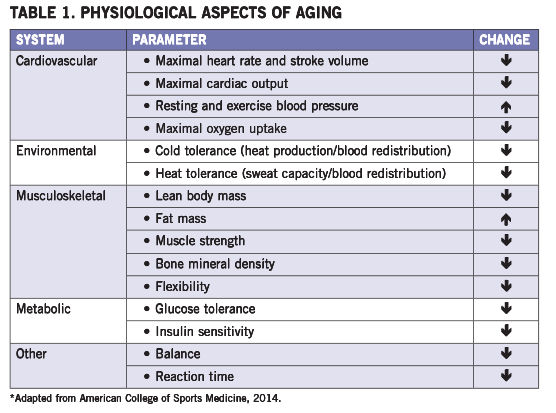
10 key exercise programming tips for older adults
Keeping these goals in mind, use the following 10 tips to guide your programming decisions for your older-adult clients.
1. Incorporate Regular Balance Training
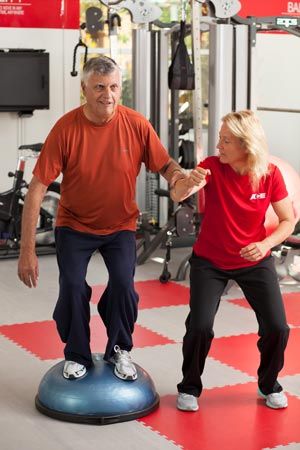
Improving proprioception should be a primary goal when designing exercise programs for older adults. Regularly incorporating flexibility, balance and lumbar strength training into the exercise design can increase adherence and quality of life. Loss of mobility and balance results in approximately 2.5 million older adults being treated in emergency departments each year for broken bones or head injuries (Centers for Disease Control and Prevention, 2014). After the age of 30, adults lose on average 3 to 8 percent of their muscle mass per decade, which results in decreased muscle strength and power (English and Paddon-Jones, 2010). Functional balance training is essential for older adults to ensure the maintenance of important activities of daily living, such as bathing, getting dressed and stair climbing.
The ability to divide attention between a proprioceptive and a cognitive task is known as dual tasking, which is common in everyday life. Balance-training programs for the older-adult population should focus on functional and progressive tasks of daily living. The aim of a balance-training program is to improve gait and balance deficits in older adults and reduce the fear of falling to increase self-esteem and physical activity. Some examples of different training programs include dual- and multitask exercises related to falling, such as spelling words while doing balance exercises, standing core exercises and TRX suspension training. Additional information on balance programing can be found here.
2. Understand Common Response Interactions Between Medication and Exercise
In addition to exercise, millions of Americans currently take prescribed medications to manage various chronic conditions, such as high cholesterol, hypertension, type 2 diabetes and cardiovascular disease. Therefore, it is critical that you understand the interaction of certain medications with the exercise response. The five most common medications prescribed to older adults are beta blockers, ACE inhibitors, diuretics, antihyperlipidemics and antidiabetics, with the percentage of American adults taking these medications increasing at age 65 and older (National Center for Health Statistics, 2012). Beta blockers elicit lower heart rate and blood pressure responses to a given exercise workload. Individuals on ACE inhibitors and diuretics have both lower resting and exercise blood pressure values. A primary concern for individuals taking ACE inhibitors and diuretics is that the combination of the reduction in blood pressure from both of these categories of medications, combined with a naturally occurring post-exercise hypotension, can result in excessive reductions in blood pressure. For individuals who take statins, it is advised to take caution with intense exercise due to the association between the drug and exertional rhabdomyolysis. Finally, oral hypoglycemics influence the transport of glucose from the blood into skeletal muscle and can increase the potential risk for exercise-induced hypoglycemia. Additional information on the interaction of common medications with exercise responses can be found here.
3. Maintenance and Compliance Should Be Considered Key Program Outcomes
It has been reported that 50 percent of people beginning an exercise program will not adhere to the program for more than six months, even though exercise adherence is a key factor in the prevention and management of chronic diseases, risk factors and functional disabilities associated with aging (Buckworth and Dishman, 2007; Blumenthal and Gullette, 2002). The latest census data found that only 26 percent of people age 65 and 18 percent of people over the age of 75 get enough exercise to make a positive impact on their health (U.S. Statistical Abstract, 2011). However, while these percentage values are low, compliance must be emphasized in this older population to achieve favorable outcomes (i.e., lower incidence of hypertension and diabetes, prevention or delay of osteoporosis, lower triglycerides and cholesterol, a decrease of obesity and musculoskeletal disorders, and fewer depressive symptoms and stress) (CDC, 2008). Similarly, longitudinal data suggests that older adults who engage in regular exercise exhibit a healthier profile when compared to those who don’t exercise regularly (Mobily, 2014). While exercising is important, emphasizing adherence to an exercise intervention may be of greater importance to older adults. To encourage adherence, programs for older adults should encourage preferred modalities such as walking in groups on outdoor trails, walking on a treadmill or around neighborhoods, resistance training focused on functionality of movement, aquatic exercise, yoga, tai chi and balance exercises.
4. Mental Health Is Equally Important to Physical Health
Not only is regular exercise beneficial in attenuating the aforementioned decline in physiological characteristics with aging, exercise also aids in the maintenance and improvement in psychological well-being. Research suggests that higher physical fitness and regular aerobic exercise training are associated with decreased risk of depression and anxiety, improved self-concept and self-esteem, increased self-efficacy, and with encouraging sustained behavioral change in sedentary individuals (Chodzko-Zaiko et al., 2009). Similarly, improvements in overall cognitive function have been seen following a 24-week resistance-training protocol (Cassilhas et al., 2007). With the associated psychological and physiological improvements to mental health, it is important that you pay considerable attention to psychological well-being during intake interviews and throughout exercise progression and note any changes that occur.
5. Use the Talk Test to Monitor Aerobic Exercise Intensity
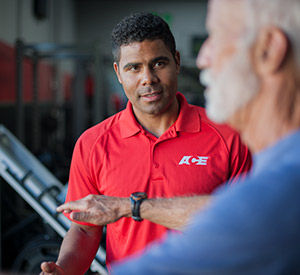
Generally, a percentage of maximal heart rate is accepted as a viable method to quantify aerobic exercise intensity. However, as individuals age, they can differ greatly in the physiological response to exercise (i.e., heart-rate response) because aging is not a uniform process across the population (ACSM, 2014). Therefore, the 0 to 10 ratings of perceived exertion (RPE) scale is often recommended for use with older adults to classify aerobic exercise intensity, with a rating of 5 to 6 for moderate intensity and 7 to 8 for vigorous intensity (Nelson et al., 2007). However, the desired level of exercise intensity may not be achieved while using the RPE method due to subjectivity of the measurement. An alternative measure of aerobic intensity is the talk test, which is a practical way to identify ventilatory thresholds (Porcari, Bryant and Comana, 2015). The talk test helps to individualize aerobic exercise intensity recommendations, and has been shown to be valid on both the treadmill and bike (Persinger et al., 2004).
To implement the talk test, pay close attention to the ability of your client to talk as he or she is exercising. As exercise intensity increases, talking will become more difficult as the client nears the first ventilatory threshold. Eventually, talking will become very uncomfortable the closer the client gets to the second ventilatory threshold. Beyond the second ventilatory threshold, clients will have great difficulty talking (Porcari, Bryant and Comana, 2015). To anchor the talk test to the RPE scale, a 5 is associated with talking with groups of four to five words between breaths and a 7 is equal to the participant being unable to talk and keep the same pace. Therefore, the talk test serves as a practical way to establish and monitor aerobic exercise intensity in older adults.
6. Use RPE (Not %1-RM) to Quantify Resistance Training Intensity
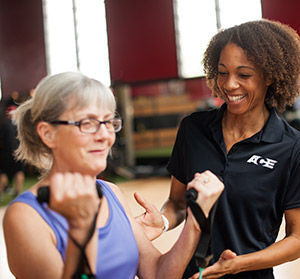
During the aging process, there is generally a reduction in muscle mass, which leads to declines in muscular strength, power, endurance, balance and mobility. These negative effects of aging can be attenuated by a progressive resistance-training program, with results of 25 percent to more than 100 percent improvements in muscular strength (Porcari, Bryant and Comana, 2015). Traditionally, when recommending resistance-training exercise, a percentage of one-repetition maximum (1-RM) is used to quantify intensity (ACSM, 2014). However, performing maximal work (true 1-RM or equating max from maximal repetitions) may be contraindicated due to many older adults falling into the moderate- and high-risk categories for risk stratification. Therefore, an alternative approach using RPE is suggested when working with older adults (Nelson et al., 2007). To maximize strength gains in older adults, a total of eight to 10 resistance-training exercises on two or more non-consecutive days with 10 to 15 repetitions per set are needed. The overall resistance should account for a moderate-to-high RPE of 5 to 6 and 7 to 8, respectively, when using a 0 to 10 scale (ACSM, 2014). By implementing the RPE method, the risk of performing maximal work is removed.
7. Incorporate Eccentric Exercises Into the Training Program
Recently, the use of eccentric exercise (which focuses on the lengthening phase of a muscle action while force is being applied) has drawn considerable interest for improving overall strength. Eccentric exercise has properties of high-force production with an overall low energy cost, making this exercise modality appealing for use with older adults (Porcari, Bryant and Comana, 2015). Indeed, research suggests that implementing eccentric exercises consisting of two sets of 10 repetitions over four months can elicit considerable improvements in strength (Reeves et al., 2009). Similarly, a recent review of the topic found eccentric resistance training to be effective in helping to attenuate the physiological declines that occur during the aging process (Gluchowski et al., 2015). However, it should also be noted that a variety of eccentric resistance-training protocols have been utilized in past research studies, and there is currently no single “best set protocol” for use with older adults. As with many training variables, a gradual progression of eccentric resistance training should be prescribed to help avoid muscle damage.
8. Integrate HIIT Into the Older Adult Exercise Routine
High-intensity interval training (HIIT) involves alternating brief bouts (30 seconds to five minutes) of higher-intensity sessions with either rest or lower-intensity workloads throughout an exercise routine. HIIT has traditionally been used to train athletes requiring high levels of both aerobic and anaerobic fitness (e.g., track and team sport athletes). Recently, numerous studies have demonstrated that HIIT may be a more time-efficient approach than continuous moderate exercise to achieve specific health benefits in the older adult segment of the population (Bruseghini et al., 2015). For example, Knowles and colleagues (2015) had participants perform HIIT sessions on a cycle ergometer once every five days for six weeks (nine total HIIT sessions), with each session consisting of 6 x 30 second sprints at workloads equating to 90 to 100 percent maximal oxygen uptake (VO2max). The 30-second interval bouts were interspersed with three minutes of active recovery that was comprised of low workloads (0 to 50 Watts) performed at a self-selected speed.
Overall, the research to date on the effectiveness of HIIT in older adults shows that it improves quality of life, motivation to exercise, and levels of cardiorespiratory fitness. One of the most important things to remember when integrating HIIT into the exercise routines of older-adult clients is to provide additional recovery. Critically, Knowles and colleagues (2015) clearly demonstrated that five days of recovery is required between HIIT sessions for older adults.
9. Encourage Flexibility Activity and in the Right Order
Flexibility, which is an essential component of physical fitness, decreases with age and physical inactivity. Poor flexibility, coupled with decreased musculoskeletal strength, has been connected with a diminished ability to perform activities of daily living (ACSM, 2014). Consequently, the beneficial effect of static stretching on the achievement and maintenance of flexibility should not be overlooked. The guidelines for designing flexibility programs for older adults are similar to those of younger individuals. Over the past decade, there has seen considerable scientific inquiry on the topic of pre-exercise stretching and performance/risk of injury. Collectively, present research findings suggest that there are no ergogenic benefits, and potentially detrimental effects (decreased muscle strength and endurance, impaired balance, and diminished reaction time) to incorporating static stretching exercises into a warm-up routine (Simic, Sarabon and Markovic, 2013). These findings are consistent among different populations and research designs, including untrained and trained individuals, recreational and competitive athletes, men and women, and with or without an aerobic warm-up (Simic, Sarabon and Markovic, 2013). Accordingly, be mindful of this robust evidence when designing programs for older adult clientele and ensure that flexibility activity is sequenced after cardiorespiratory, resistance and balance-training components.
10. Special Considerations for Programming for Older Clients with Comorbidities
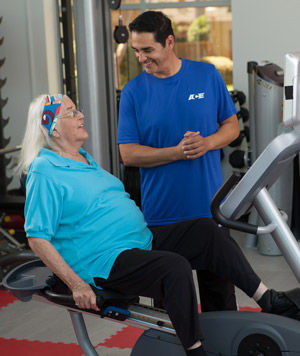
Approximately 80 percent of individuals aged 65 years or older are living with at least one chronic health problem, and another 50 percent are living with two chronic conditions. Moreover, the presence of specific chronic conditions is associated with an even greater propensity of comorbidities. Indeed, almost all individuals with diabetes have at least one other chronic condition and nearly half have three or more comorbidities (Wolf, Starfield and Anderson, 2002). These factors make it increasingly likely that you will be interacting with clients who have multiple chronic conditions. Currently, numerous health organizations, including the American Council on Exercise, list sedentary lifestyle as a controllable risk factor for many chronic health conditions (Porcari, Bryant and Comana, 2015). Accordingly, exercise is a common therapeutic intervention strategy for persons with multiple chronic conditions. Here are several tips for designing programs for older clients with comorbidities:
- It is highly probable that individuals with multiple chronic conditions will be stratified into a high-risk category and will thus require physician clearance to participate in an exercise program.
- You and your client should ask the client’s medical team about any specific limitations to be aware of when designing the exercise program (e.g., specific exercises to avoid).
- One strategy to employ when working with clients with comorbidities is to design the overall exercise program around the condition that poses the greatest risk of mortality for the individual.
- Individuals with multiple comorbidities may possess conditions that fluctuate significantly from day-to-day in terms of severity (e.g., low-back pain, osteoarthritis, fibromyalgia). You must be prepared to accommodate an ever-changing chronic-condition landscape with these types of clients and constantly adjust the session to best serve your clients on any given day.
References
American College of Sports Medicine (2014). ACSM’s Guidelines for Exercise Testing and Prescription (9th ed.). Baltimore: Wolters Kluwer/Lippincott Williams and Wilkins.
Blumenthal, J.A. and Gullette, E.C.D. (2002). Exercise interventions and aging: Psychological and physical health benefits in older adults. In: K.W. Schaie, H. Leventhal and S.L. Willis (Eds.), Effective Health Behavior in Older Adults (pp. 157–178). New York: Springer.
Booth, F.W. et al. (2000). Waging war on modern chronic diseases: primary prevention through exercise biology. Journal of Applied Physiology, 88, 774-787.
Bruseghini, P. et al. (2015). Effects of eight weeks of aerobic interval training and of isoinertial resistance training on risk factors of cardiometabolic diseases and exercise capacity in healthy elderly subjects. Oncotarget, 6, 16998-17015.
Buckworth, J. and Dishman, R.K. (2007). Exercise adherence. In: G. Tannenbaum and R.C. Eklund (Eds.), Handbook of Sport Psychology (3rd ed., pp. 509–536). Hoboken, N.J.: Wiley.
Cassilhas, R.C. et al. (2007). The impact of resistance exercise on the cognitive function of the elderly. Medicine & Science in Sport & Exercise, 39, 1401-1407.
Centers for Disease Control and Prevention (2014). Facts About Physical Activity.
Chodzko-Zajko, W.J. et al. (2009). Exercise and physical activity for older adults. Medicine & Science in Sports & Exercise, 41, 1510-1530.
Dempsey, J. and Seals, D. (1995). Aging, exercise and cardiopulmonary function. In: D.R. Lamb, C.V. Gisolfi and E. Nadel (Eds.). Exercise in Older Adults (pp. 237–304). Carmel, Ill.: Cooper Publishing Group.
English, K.L. and Paddon-Jones, D. (2010). Protecting muscle mass and function in older adults during bed rest. Current Opinion in Clinical Nutrition and Metabolic Care, 13, 34-39.
Gluchopwski, A. et al. (2015). Chronic eccentric exercise and the older adult. Sports Medicine, 45, 1413-1430.
Knowles, A.M. et al. (2015). Impact of low-volume, high-intensity interval training on maximal aerobic capacity, health-related quality of life and motivation to exercise in ageing men. Age (Dordrecht, Netherlands), 37, 25.
Mobily, K. (2014). Exercise practice and compliance in community-dwelling older adults. Journal of Park and Recreation Administration, 32, 96-109.
National Center for Health Statistics (2012). Health, United States, 2011. Hyattsville, Md.
Nelson, M.E. et al. (2007). Physical activity and public health in older adults: Recommendations from the American College of Sports Medicine and the American Heart Association. Circulation, 116, 1094-1105.
Persinger, R. et al. (2004). Consistency of the talk test for exercise prescription. Medicine & Science in Sports & Exercise, 36, 1632-1636.
Porcari, J.P., Bryant, C.X. and Comana, F. (2015). Exercise Physiology (Foundations of Exercise Science). Philadelphia: F.A. Davis.
Reeves, N.D. et al (2009). Differential adaptations to eccentric versus conventional resistance training in older humans. Experimental Physiology, 94, 825-833.
Simic, L., Sarabon, N. and Markovic, G. (2013). Does pre-exercise static stretching inhibit maximal muscular performance? A meta-analytical review. Scandinavian Journal of Medicine and Science in Sports, 23, 131-148.
U.S. Statistical Abstract. (2011). Age-adjusted percentage of persons engaging in physical activity and fitness by selected characteristic: 2008.
Wolf, J.L., Starfield, B. and Anderson, G. (2002). Prevalence, expenditures and complications of multiple chronic conditions in the elderly. Archives of Internal Medicine, 162, 2269-2276.





